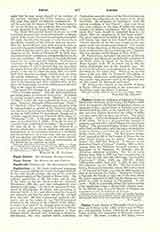

Paphnutius.—I. The most celebrated personage of this name was bishop of a city in the Upper Thebaid in the early fourth century, and one of the most interesting members of the Council of Nicaea (325). He suffered mutilation of the left knee and the loss of his right eye for the Faith under the Emperor Maximinus (308-13), and was subsequently condemned to the mines. At Nicaea he was greatly honored by Constantine the Great, who, according to Socrates (H. E., I, 11), used often to send for the good old confessor and kiss the place whence the eye had been torn out. He took a prominent, perhaps a decisive, part in the debate at the First Ecumenical Council on the subject of the celibacy of the clergy. It seems that most of the bishops present were disposed to follow the precedent of the Council of Elvira (can. xxxiii) prohibiting conjugal relations to those bishops, priests, deacons, and, according to Sozomen, sub-deacons, who were married before ordination. Paphnutius earnestly entreated his fellow-bishops not to impose this obligation on the orders of the clergy concerned. He proposed, in accordance “with the ancient tradition of the Church“, that only those who were celibates at the time of ordination should continue to observe continence, but, on the other hand, that “none should be separated from her, to whom, while yet unordained, he had been united”. The great veneration in which he was held, and the well known fact that he had himself observed the strictest chastity all his life, gave weight to his proposal, which was unanimously adopted. The council left it to the discretion of the married clergy to continue or discontinue their marital relations. Paphnutius was present at the Synod of Tyre (335). II. PAPHNUTIUS, surnamed (on account of his love of solitude) THE BUFFALO, an anchorite and priest of the Scetic desert in Egypt in the fourth century. When Cassian (Coll., IV, 1) visited him in 395, the Abbot Paphnutius was in his ninetieth year. He never left his cell save to attend church on Saturdays and Sundays, five miles away. When in his paschal letter of the year 399, the Patriarch Theophilus of Alexandria condemned anthropomorphism, Paphnutius was the only monastic ruler in the Egyptian desert who caused the document to be read. III. PAPHNUTIUS, deacon of the church of Boou, in Egypt, suffered martyrdom in the persecution of Diocletian, under the Prefect Culcianus.
MAURICE M. HASSETT

